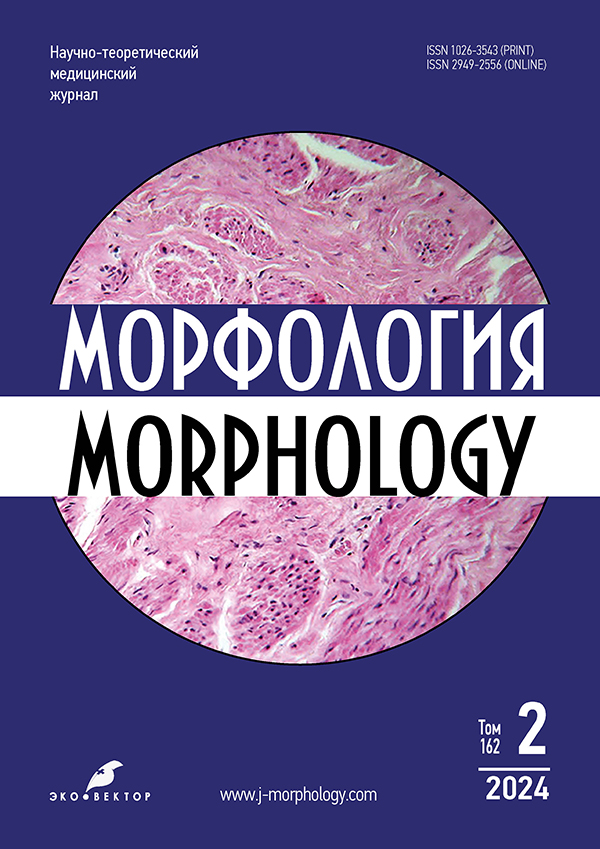炎症性肠病不同病程阶段上皮细胞的细胞差异组成
- 作者: Bernardelli L.I.1, Indeickin F.A.2, Matyusheva L.G.1, Emelin A.M.3, Skalinskaya M.I.1, Nekrasova A.S.1, Deev R.V.3
-
隶属关系:
- North-Western State Medical University named after I.I. Mechnikov
- National Center for Clinical Morphological Diagnostics
- Petrovsky National Research Centre of Surgery
- 期: 卷 162, 编号 2 (2024)
- 页面: 127-139
- 栏目: Original Study Articles
- ##submission.dateSubmitted##: 16.06.2024
- ##submission.dateAccepted##: 19.07.2024
- ##submission.datePublished##: 10.11.2024
- URL: https://j-morphology.com/1026-3543/article/view/633461
- DOI: https://doi.org/10.17816/morph.633461
- ID: 633461
如何引用文章
详细
论证。由于炎症性肠病的病例数量不断增加,而且缺乏可靠的征兆,因此需要建立一定的形态学鉴别诊断标准。
这项研究的目的是确定 Crohn 病和溃疡性结肠炎恶化期和缓解期肠上皮细胞的差异组成。
材料和方法。研究对象为炎症性肠病患者(Crohn 病,30 人;溃疡性结肠炎,30 人)和肠易激综合征患者(对比组,15 人)的组织材料。研究采用了组织学、免疫组化和统计学方法。
结果。在所有列出的病种中,回肠、升结肠、乙状结肠和直肠粘膜上皮细胞差异子组成的特殊性均已确定。此外,还对炎症性肠病的加重期和缓解期进行了评估。结果发现,褐藻细胞在上皮细胞中所占的比例因肠道科室、病名和病程阶段而异。
梭形细胞分化:与缓解期相比,Crohn 疾病加重期回肠隐窝之间的表面上皮粘液细胞增加了 25.0%(p=0.0002);与肠易激综合征相比,升结肠表面上皮中的梭形细胞增加了 42.9%(p=0.0001);与溃疡性结肠炎急性期相比,乙状结肠中的隐窝梭形细胞增加了 23.0%(p=0.0024)。Paneth 细胞的数量差异没有统计学意义。与肠易激综合征相比,Crohn 病急性期乙状结肠内分泌细胞的数量高出 3 倍(p=0.0238)。
非上皮细胞:缓解期与恶化期相比,Crohn 疾病的上皮内淋巴细胞数量更少--乙状结肠为 2.4 倍,直肠为 4.0 倍(p<0.0001);与肠易激综合征相比--回肠为 4.8 倍,升结肠为 2.7 倍,乙状结肠为 4.0 倍(p<0.05);与缓解期溃疡性结肠炎相比--直肠为 8.0 倍(p=0.0004)。研究发现,与溃疡性结肠炎相比,Crohn 病急性期乙状结肠肠隐窝上皮细胞(主要是梭形细胞)的增殖活性增加了 4.2 倍(p=0.0016)。
结论。在确定肠上皮细胞分化组成时,已经建立了可用作鉴别诊断标准的形态计量参数。与溃疡性结肠炎恶化期相比,Crohn 疾病恶化期的特点是乙状结肠隐窝上皮的增殖指数增加。与同一阶段的溃疡性结肠炎相比,缓解期 Crohn 疾病的特点是直肠上皮内淋巴细胞数量较少。
全文:
作者简介
Liudmila I. Bernardelli
North-Western State Medical University named after I.I. Mechnikov
Email: bernardellimila@gmail.com
ORCID iD: 0000-0001-9077-7718
SPIN 代码: 5671-1891
doctor
俄罗斯联邦, 47 Piskarevsky Prospekt, 195067 Saint PetersburgFedor A. Indeickin
National Center for Clinical Morphological Diagnostics
Email: f.indeickin@yandex.ru
ORCID iD: 0000-0002-1436-2235
SPIN 代码: 4627-4445
doctor of pathological anatomy
俄罗斯联邦, Saint PetersburgLilia G. Matyusheva
North-Western State Medical University named after I.I. Mechnikov
Email: liliali2719@gmail.com
ORCID iD: 0000-0003-1746-8059
SPIN 代码: 3658-3376
student of the faculty of Preventive Medicine
俄罗斯联邦, 47 Piskarevsky Prospekt, 195067 Saint PetersburgAlexey M. Emelin
Petrovsky National Research Centre of Surgery
Email: eamar40rn@gmail.com
ORCID iD: 0000-0003-4109-0105
SPIN 代码: 5605-1140
doctor of pathological anatomy
俄罗斯联邦, MoscowMaria I. Skalinskaya
North-Western State Medical University named after I.I. Mechnikov
Email: Mariya.Skalinskaya@szgmu.ru
ORCID iD: 0000-0003-0769-8176
SPIN 代码: 2596-5555
MD, Cand. Sci. (Medicine), Assistant Professor
俄罗斯联邦, 47 Piskarevsky Prospekt, 195067 Saint PetersburgAnna S. Nekrasova
North-Western State Medical University named after I.I. Mechnikov
Email: Anna.Nekrasova@szgmu.ru
ORCID iD: 0000-0001-5198-9902
SPIN 代码: 7502-5036
MD, Cand. Sci. (Medicine), Assistant Professor
俄罗斯联邦, 47 Piskarevsky Prospekt, 195067 Saint PetersburgRoman V. Deev
Petrovsky National Research Centre of Surgery
编辑信件的主要联系方式.
Email: romdey@gmail.com
ORCID iD: 0000-0001-8389-3841
SPIN 代码: 2957-1687
MD, Cand. Sci. (Medicine), Assistant Professor
俄罗斯联邦, Moscow参考
- Ocansey DKW, Wang L, Wang J, et al. Mesenchymal stem cell-gut microbiota interaction in the repair of inflammatory bowel disease: an enhanced therapeutic effect. Clin Transl Med. 2019;8(1):31. doi: 10.1186/s40169-019-0251-8
- Maev IV, Shelygin YuA, Skalinskaya MI, et al. The pathomorphosis of inflammatory bowel diseases. Annals of the Russian Academy of Medical Sciences. 2020;75(1):27–35. EDN: FWJIAO doi: 10.15690/vramn1219
- Tkachev AV, Mkrtchyan LS, Mazovka KE, Bohanova EG. In the labyrinths of pathogenesis: the environment and metamorphosis of IBD. South Russian Journal of Therapeutic Practice. 2021;2(3):30–39. EDN: KZOSKG doi: 10.21886/2712-8156-2021-2-3-30-39
- Kononova YA, Likhonosov NP, Babenko AY. Metformin: expanding the scope of application-starting earlier than yesterday, canceling later. Int J Mol Sci. 2022;23(4):2363. doi: 10.3390/ijms23042363
- Yu Y, Yang W, Li Y, Cong Y. Enteroendocrine cells: sensing gut microbiota and regulating inflammatory bowel diseases. Inflamm Bowel Dis. 2020;26(1):11–20. doi: 10.1093/ibd/izz217
- Ocansey DKW, Zhang L, Wang Y, et al. Exosome-mediated effects and applications in inflammatory bowel disease. Biol Rev Camb Philos Soc. 2020;95(5):1287–1307. doi: 10.1111/brv.12608
- Fernández-Tomé S, Ortega Moreno L, Chaparro M, Gisbert JP. Gut microbiota and dietary factors as modulators of the mucus layer in inflammatory bowel disease. Int J Mol Sci. 2021;22(19):10224. doi: 10.3390/ijms221910224
- Kovaleva AL, Poluektova EA, Shifrin OS. Intestinal barrier, permeability and nonspecific inflammation in functional gastrointestinal disorders. Russian Journal of Gastroenterology, Hepatology, Coloproctology. 2020;30(4):52–59. EDN: EAPBNM doi: 10.22416/1382-4376-2020-30-4-52-59
- Ng QX, Soh AYS, Loke W, et al. The role of inflammation in irritable bowel syndrome (IBS). J Inflamm Res. 2018;11:345–349. doi: 10.2147/JIR.S174982
- Kirsch R, Riddell R. Histopathological alterations in irritable bowel syndrome. Mod Pathol. 2006;19(12):1638–1645. Corrected and republished from: Mod Pathol. 2007;20(2):278. doi: 10.1038/modpathol.3800704
- Lockhart A, Mucida D, Bilate AM. Intraepithelial Lymphocytes of the Intestine. Annu Rev Immunol. 2024;42(1):289–316. doi: 10.1146/annurev-immunol-090222-100246
- Tavakoli P, Vollmer-Conna U, Hadzi-Pavlovic D, Grimm MC. A review of inflammatory bowel disease: a model of microbial, immune and neuropsychological integration. Public Health Rev. 2021;42:1603990. doi: 10.3389/phrs.2021.1603990
- Sharapov IY, Kvaratskheliiya AG, Bolgucheva MB, Korotkikh KN. Functional morphology of goblet cells of the small intestine under the influence of various factors. Journal of Anatomy and Histopathology. 2021;10(2):73–79. EDN: NEDOPW doi: 10.18499/2225-7357-2021-10-2-73-79
- Churkova ML, Kostyukevich SV. The epithelium mucosal of colon in normal and in functional and inflammatory bowel diseases. Experimental and Clinical Gastroenterology Journal. 2018;(5):128–132. EDN: XZJCPJ
- Mavlikeev MO, Arkhipova SS, Chernova ON, et al. A short course in histological technique. Kazan: Kazan University; 2020. 107 р. (In Russ.)
- Kononov AV, Mozgovoy SI, Shimanskaya AG. Lifetime pathologic and anatomical diagnosis of diseases of the digestive system (class XI ICD-10). Clinical recommendations RPS3.11(2018). Moscow: Practical medicine; 2019. 191 р. (In Russ.)
- Ivashkin VT, Shelygin YuA, Abdulganieva DI, et al. Crohn’s disease. Clinical recommendations (preliminary version). Koloproktologia. 2020;19(2):8–38. EDN: AGKJNF doi: 10.33878/2073-7556-2020-19-2-8-38
- General Assembly of the World Medical Association. World Medical Association Declaration of Helsinki: ethical principles for medical research involving human subjects. J Am Coll Dent. 2014;81(3):14–18.
- Singh V, Johnson K, Yin J, et al. Chronic inflammation in ulcerative colitis causes long-term changes in goblet cell function. Cell Mol Gastroenterol Hepatol. 2022;13(1):219–232. doi: 10.1016/j.jcmgh.2021.08.010
- Kang Y, Park H, Choe BH, Kang B. The role and function of mucins and its relationship to inflammatory bowel disease. Front Med (Lausanne). 2022;9:848344. doi: 10.3389/fmed.2022.848344
- Zolotova NA, Akhrieva KM., Zayratyants OV. Epithelial barrier of the colon in health and patients with ulcerative colitis. Experimental and Clinical Gastroenterology Journal. 2019;(2):4–13. EDN: SUBULS doi: 10.31146/1682-8658-ecg-162-2-4-13
- Rezzani R, Franco C, Franceschetti L, et al. A focus on enterochromaffin cells among the enteroendocrine cells: localization, morphology, and role. Int J Mol Sci. 2022;23(7):3758. doi: 10.3390/ijms23073758
- Tao E, Zhu Z, Hu C, et al. Potential roles of enterochromaffin cells in early life stress-induced irritable bowel syndrome. Front Cell Neurosci. 2022;16:837166. doi: 10.3389/fncel.2022.837166
- Knyazev OV, Shkurko TV, Fadeyeva NA, et al. Epidemiology of chronic inflammatory bowel disease. Yesterday, today, tomorrow. Experimental and Clinical Gastroenterology Journal. 2017;(3):4–12. EDN: ZRPJFX
补充文件








